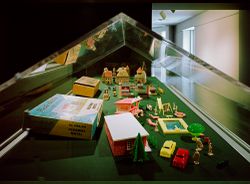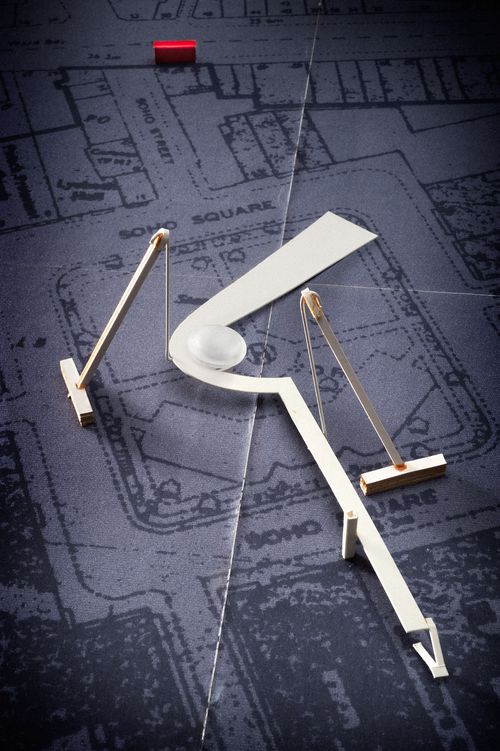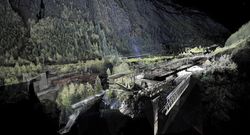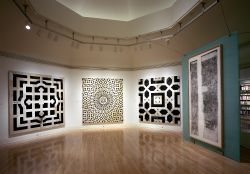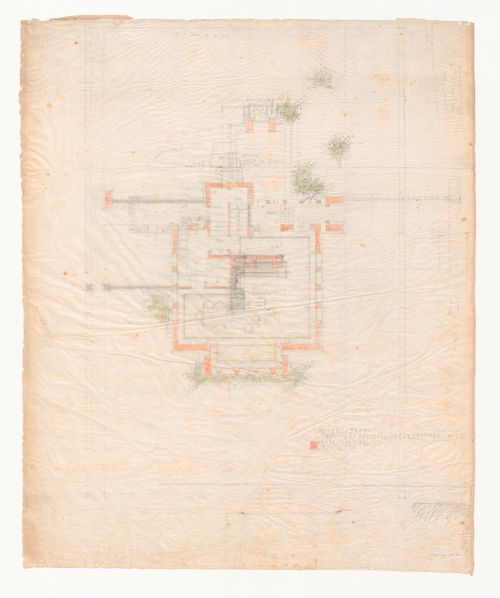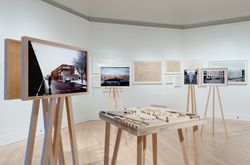Not only do toys provide evidence of the social and economic life of their period, but architectural toys ranging from wooden building blocks to iron and steel construction sets reflect distinct stylistic predilections and technological advances. New industrial and building techniques were used not only to create the new building types transforming our cities, but were(...)
Octagonal gallery
28 November 1990 to 31 March 1991
Buildings in Boxes: Architectural Toys from the CCA
Actions:
Description:
Not only do toys provide evidence of the social and economic life of their period, but architectural toys ranging from wooden building blocks to iron and steel construction sets reflect distinct stylistic predilections and technological advances. New industrial and building techniques were used not only to create the new building types transforming our cities, but were(...)
Octagonal gallery
DR2004:0797
Description:
scaled site plan model of Magnet #2
1995-1996
Magnet: Presentation model for site #2, Soho Square, London
Actions:
DR2004:0797
Description:
scaled site plan model of Magnet #2
Launched in November 1998 by the International Foundation for the Canadian Centre for Architecture, The CCA Competition for the Design of Cities invited architects from around the world to submit solutions to a problem facing all major cities at the dawn of the twenty-first century: how to repair the scars left by transportation structures that are vestiges from a bygone(...)
Main galleries
15 November 2000 to 1 April 2001
New York: CCA Competition for the Design of Cities
Actions:
Description:
Launched in November 1998 by the International Foundation for the Canadian Centre for Architecture, The CCA Competition for the Design of Cities invited architects from around the world to submit solutions to a problem facing all major cities at the dawn of the twenty-first century: how to repair the scars left by transportation structures that are vestiges from a bygone(...)
Main galleries
archives
Level of archival description:
Fonds
AP198
Synopsis:
The Kivi Sotamaa OCEAN North project records, 1997-2000, consist of born-digital files, drawings, photographs, and physical models that document two projects by the OCEAN North collective: Jyväskylä Music and Arts Centre (competition, 1997) and Tölöö Football Stadium (competition, 1997). The archive also includes born-digital reference materials on 14 projects from the collective, including the two projects mentioned above.
1997-2000
Kivi Sotamaa OCEAN North project records
Actions:
AP198
Synopsis:
The Kivi Sotamaa OCEAN North project records, 1997-2000, consist of born-digital files, drawings, photographs, and physical models that document two projects by the OCEAN North collective: Jyväskylä Music and Arts Centre (competition, 1997) and Tölöö Football Stadium (competition, 1997). The archive also includes born-digital reference materials on 14 projects from the collective, including the two projects mentioned above.
archives
Level of archival description:
Fonds
1997-2000
In this lecture, Christophe Girot discusses digital landscape models: A quiet revolution has taken place in digital landscape design and analysis over the past decade, caused by the introduction of digital point-cloud models. The scope and precision of these digital landscape models, created with terrestrial laser scanners and mobile and airborne lidar, lead to new(...)
Paul Desmarais Theatre
6 October 2016, 6pm
Unravelling the Digital Landscape
Actions:
Description:
In this lecture, Christophe Girot discusses digital landscape models: A quiet revolution has taken place in digital landscape design and analysis over the past decade, caused by the introduction of digital point-cloud models. The scope and precision of these digital landscape models, created with terrestrial laser scanners and mobile and airborne lidar, lead to new(...)
Paul Desmarais Theatre
This exhibition presents American architect Ben Nicholson’s search for order, meaning, and logic in a world of art, science, and mystery. The Laurentian Library in Florence, a masterwork by Michelangelo designed in 1524–25, contains fifteen pairs of terra cotta panels bearing complex geometric patterns that have been long hidden from view. Nicholson studied the panels at(...)
Octagonal gallery
11 December 1996 to 9 March 1997
Uncovering Geometry: Ben Nicholson at the Laurentian Library
Actions:
Description:
This exhibition presents American architect Ben Nicholson’s search for order, meaning, and logic in a world of art, science, and mystery. The Laurentian Library in Florence, a masterwork by Michelangelo designed in 1524–25, contains fifteen pairs of terra cotta panels bearing complex geometric patterns that have been long hidden from view. Nicholson studied the panels at(...)
Octagonal gallery
Project
AP143.S4.D65
Description:
File documents the unexecuted project for the University Art Museum, Long Beach, California. Material in this file was produced between 1986 and 1988. California State University, Long Beach (CSULB), commissioned Eisenman/Robertson Architects to design an art museum adjacent to the main campus entrance. The 67,500-square-foot building was to comprise four galleries, a black-box theater, an auditorium, a cafe, conference rooms, a library, offices, preparation spaces, and storage vaults. The project, sited on a 23-acre arboretum, included landscaping; terraced sculpture courtyards, botanical gardens, and a two-acre pond. Eisenman linked the northern and southern parts of the arboretum by an elevated public walkway through the museum. Sets of drawings were presented on 8 and 30 April, 2 June, and 5 Aug. In the first design phase Eisenman explores the cartographic figures which form the basis of his artificial excavation when superposed: a series of sketches establishes the analogical relationships which fix the relative scales of the plans and produce the superpositions; another series contextualizes the superposed figures by placing them within the museum site (DR1987:0859:087-090). The second phase concerns the building; the working model shows the building carved out of a square pit, from which spring an oil derrick and a reconstruction of a recreational pier (Rainbow Pier, 1920s) used here as circulatory bridge (DR1987:0859:160). In the third phase the architect systematizes his archeological procedure by using five significant cartographic dates - 1849, 1889, 1949, 1989, 2049 - each corresponding to a specific superposition (see DR1987:0859:274-277). In the fourth phase, Eisenman simplifies the superposition of 2049 to a few iconic colour-coded forms: ranch (green), ranch house (blue), campus site (red), and water forms (river and pond) (gold). Material for the fourth phase includes three relief models, four presentation drawings, and a model (property of the CSULB) (relief models: DR1987:0859:001-003; drawings: DR1987:0859:004-008). Eisenman "inhabits" his artifical archeology by detailed planning of interior spaces, and gives substance to the cartographic traces in a series of sketch sections, perspectives, and working models. Working models reveal how the central "canal" area gradually became the museum's access point (DR1987:0859:484-490); the museum, galleries, offices, and preparation areas are on one side of this deep cut, while the cafeteria and black-box theater are on the other. The upper level was to house offices, meeting rooms, and the library. File contains audiovisual material, conceptual drawings, design development drawings, presentation drawings, reference drawings, working drawings, photographic materials, and textual records.
1986-1988
University Art Museum
Actions:
AP143.S4.D65
Description:
File documents the unexecuted project for the University Art Museum, Long Beach, California. Material in this file was produced between 1986 and 1988. California State University, Long Beach (CSULB), commissioned Eisenman/Robertson Architects to design an art museum adjacent to the main campus entrance. The 67,500-square-foot building was to comprise four galleries, a black-box theater, an auditorium, a cafe, conference rooms, a library, offices, preparation spaces, and storage vaults. The project, sited on a 23-acre arboretum, included landscaping; terraced sculpture courtyards, botanical gardens, and a two-acre pond. Eisenman linked the northern and southern parts of the arboretum by an elevated public walkway through the museum. Sets of drawings were presented on 8 and 30 April, 2 June, and 5 Aug. In the first design phase Eisenman explores the cartographic figures which form the basis of his artificial excavation when superposed: a series of sketches establishes the analogical relationships which fix the relative scales of the plans and produce the superpositions; another series contextualizes the superposed figures by placing them within the museum site (DR1987:0859:087-090). The second phase concerns the building; the working model shows the building carved out of a square pit, from which spring an oil derrick and a reconstruction of a recreational pier (Rainbow Pier, 1920s) used here as circulatory bridge (DR1987:0859:160). In the third phase the architect systematizes his archeological procedure by using five significant cartographic dates - 1849, 1889, 1949, 1989, 2049 - each corresponding to a specific superposition (see DR1987:0859:274-277). In the fourth phase, Eisenman simplifies the superposition of 2049 to a few iconic colour-coded forms: ranch (green), ranch house (blue), campus site (red), and water forms (river and pond) (gold). Material for the fourth phase includes three relief models, four presentation drawings, and a model (property of the CSULB) (relief models: DR1987:0859:001-003; drawings: DR1987:0859:004-008). Eisenman "inhabits" his artifical archeology by detailed planning of interior spaces, and gives substance to the cartographic traces in a series of sketch sections, perspectives, and working models. Working models reveal how the central "canal" area gradually became the museum's access point (DR1987:0859:484-490); the museum, galleries, offices, and preparation areas are on one side of this deep cut, while the cafeteria and black-box theater are on the other. The upper level was to house offices, meeting rooms, and the library. File contains audiovisual material, conceptual drawings, design development drawings, presentation drawings, reference drawings, working drawings, photographic materials, and textual records.
File 65
1986-1988
DR1980:0060:002
Description:
- This first floor plan, with the perspective (DR1980:0060:001) and the second floor plan (DR1980:0060:003) form a set of early presentation drawings. The scale is probably 1/4" = 1' (see object file, de Long report). This plan indicates reworking in the porch/stair and service entrance areas which appear in Hitchcock's book (plate 201) and were built as sketched. The fireplace and seat in the living room were shifted and subsequently built as sketched, as was the ice room. The wall added to the right was shifted back in the final Hitchcock plan. The entry behind the livingroom has sketched-in doors at the rear, as seen in the Hitchcock drawing -- other doors do not yet appear, nor does the garden court. The house became more private in the final adjustments to the site. Wright's further changes are: the wall extending left was crossed out; a freehand wall is roughed in to right; heavy masonry walls are roughed in to left over former wall. (There are other miscellaneous markings and crosshatchings in the reworking.)
architecture
1915
First floor plan for Emil Bach House, Chicago, Illinois
Actions:
DR1980:0060:002
Description:
- This first floor plan, with the perspective (DR1980:0060:001) and the second floor plan (DR1980:0060:003) form a set of early presentation drawings. The scale is probably 1/4" = 1' (see object file, de Long report). This plan indicates reworking in the porch/stair and service entrance areas which appear in Hitchcock's book (plate 201) and were built as sketched. The fireplace and seat in the living room were shifted and subsequently built as sketched, as was the ice room. The wall added to the right was shifted back in the final Hitchcock plan. The entry behind the livingroom has sketched-in doors at the rear, as seen in the Hitchcock drawing -- other doors do not yet appear, nor does the garden court. The house became more private in the final adjustments to the site. Wright's further changes are: the wall extending left was crossed out; a freehand wall is roughed in to right; heavy masonry walls are roughed in to left over former wall. (There are other miscellaneous markings and crosshatchings in the reworking.)
architecture
Wohnhaus Schlesisches Tor—also known as Bonjour Tristesse—in Berlin and Punt en Komma in The Hague are Álvaro Siza’s first built works outside his native Portugal. The two projects resemble one another in size, scale, program, and ambition: both were built in the 1980s, both are results of a distinct attitude towards the city, and both were social housing projects(...)
Octagonal gallery Keyword(s):
Álvaro Siza, Punt en Komma, The Hague, Bonjour Tristesse, Berlin
24 September 2015 to 22 May 2016
Corner, Block, Neighbourhood, Cities. Álvaro Siza in Berlin and The Hague
Actions:
Description:
Wohnhaus Schlesisches Tor—also known as Bonjour Tristesse—in Berlin and Punt en Komma in The Hague are Álvaro Siza’s first built works outside his native Portugal. The two projects resemble one another in size, scale, program, and ambition: both were built in the 1980s, both are results of a distinct attitude towards the city, and both were social housing projects(...)
Octagonal gallery Keyword(s):
Álvaro Siza, Punt en Komma, The Hague, Bonjour Tristesse, Berlin
archives
Level of archival description:
Fonds
Gene Summers fonds
AP114
Synopsis:
The Gene Summers fonds documents primarily the later part of Gene Summers' career as an architect, developer, artist and art collector. Summer's early work with the Office of Mies van der Rohe and C.F. Murphy Associates is summarily represented by notes, sketches and photographs.
1957 - 2004
Gene Summers fonds
Actions:
AP114
Synopsis:
The Gene Summers fonds documents primarily the later part of Gene Summers' career as an architect, developer, artist and art collector. Summer's early work with the Office of Mies van der Rohe and C.F. Murphy Associates is summarily represented by notes, sketches and photographs.
archives
Level of archival description:
Fonds
1957 - 2004
